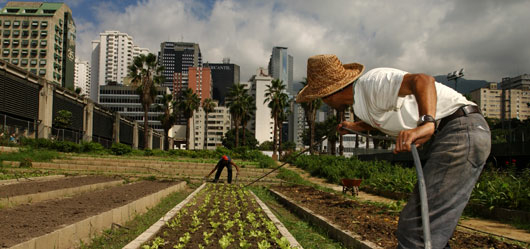Why urban farming isn’t always the solution.
If we look at the recent works of architecture students, we can define a trend. The green roof or façade, or both. We design cities with only green roofs, or sky scrapers that in itself form a food production towerand since its best to not implement such a specific feature because of purely aesthetics, students often define these areas to be used for Urban Farming. A technique that sounds very promising, but isn’t really further researched during the design projects. I know, because I used to be one of those students.
Urban farming is promoted to be sustainable, a green solution for the food problem. Giving back the land that is now used for the building, is one of those reason students use all the time, but is urban farming always the solution. This column will elaborate on some pros and cons of urban farming, and perhaps form a guideline of subjects to be researched for future projects.
One of the most heard arguments students give for urban farming is the possible added food production [1] On all these now unused square meters food can be produced; which means there’s a big potential to increase the production capability. This is true, there are a lot of square meters ready to be used, but only so much can be produced on these areas. Fruits and vegetables is most often the chosen food, but what about grains, meat, oils and other dairy products? It’s highly unlikely one will produce its own milk, by letting a cow live on top of one’s roof (but yes it could be done)
Another argument students often use to justify the implementation of urban farming in their designs is locally produced food. ‘You are what you eat,’ [2] is one of those lines. Yes, it’s true that if you produce or grow your own fruits and vegetables on your roof or garden you are the one that’s deciding on which pesticides will be used, but people often forget that the soil used for this (especially when using the garden) production of food can already be polluted. Cars and paint can influence the quality of the soil and if not noticed up front, foods grown on this soil can be poisonous [1]. Going back to the animal farming, one’s neighbour might have this, but you cannot guarantee what these animals are fed [2].
Urban farming is also often promoted as a way to create extra jobs and income [2], and even though the production can be quite large is done collectively, this is often not the case. Right now urban farming is an activity only small communities or individuals partake in. One could sell these grown fruits or vegetables to one’s neighbour, or go to a local market and sell it there, but this doesn’t weigh up against the mass production of the professional farmers. Mass produced products are often less expensive, which means it could be difficult to generate an income from one’s own food production. Besides farming for personal consumption, now the incentive of possible income lacks which could mean a lower engagement of the people.
With these examples, I hope to show that urban farming might not always be the solution one thinks it could be. What I’ve experienced until now is that the question ‘why?’ regarding the implementation of a green roof or façade is often answered by ‘urban farming’, no further questions asked. But isn’t this weird? I’m not saying urban farming isn’t an option at all, I just believe to justify the implementation of this in a design project more research needs to be done; more questions need to be asked by both the tutor as the student.
[2] Pros and cons of urban agiculture
